Bosch SHE7ER55UC, SHE8ER55UC, SHE9ER55UC Instructions for Use

Congratulations and thank you from Bosch!
Thank you for selecting a Bosch dishwasher. You have joined the many consumers who demand quiet and superior performance from their dishwashers.
This manual was written with your safety and convenience in mind, and the information contained herein is very important. We highly recommend that you read this manual before using your dishwasher for the first time.
To learn more about your dishwasher and available accessories, as well as many other top quality Bosch appliances, visit our web site at:
www.bosch-home.com/us (USA) or
www.bosch-appliances.ca (Canada)
If you have any questions or comments, please contact us at: 1-800-944-2904.
Table of Contents |
|
Important Safety Instructions........................................................ |
2-3 |
Dishwasher Components................................................................ |
4-6 |
Dishwasher Setup.......................................................................... |
6-8 |
Dishware Materials........................................................................... |
8 |
Loading the Dishwasher.................................................................. |
8-9 |
Rack Accessories........................................................................ |
10-11 |
Dishwasher Cycles and Options....................................................... |
12 |
Wash Cycle Information.................................................................. |
13 |
Operating the Dishwasher........................................................... |
13-14 |
Care and Maintenance..................................................................... |
15 |
Self Help.................................................................................... |
16-17 |
Customer Service............................................................................ |
18 |
Warranty Information...................................................................... |
19 |

IMPORTANT SAFETY INSTRUCTIONS: Please READ and SAVE this information
 WARNING
WARNING
Misuse of the dishwasher can result in serious injury or death. Do not use the dishwasher in any way not covered in this manual or for any purpose other than those explained in the following pages.
Severe product damage and/or injury could result from the use of unqualified service technicians or non-original replacement parts. All repairs must be performed by a qualified service technician using only original equipment factory replacement parts.
Electrical shock or fire could result if the electrical supply for the dishwasher covered in this manual is incorrectly installed or if the dishwasher has been improperly grounded. Do not use the dishwasher covered in this manual unless you are certain the electrical supply has been correctly installed or the dishwasher has been properly grounded.
Never use harsh chemicals to clean your dishwasher. Some chloride-containing products can damage your dishwasher and may present health hazards!
NOTICE
Never use steam cleaning products to clean your dishwasher. The manufacturer will not be liable for the possible damages or consequences.
It is highly recommended for the end user to become familiar with the procedure to shut off the incoming water supply and the procedure to shut off the incoming power supply. See the Installation Instructions or contact your installer for more information.
2

WARNING: To reduce the risk of fire, electrical shock, or serious injury, observe the following:
1This dishwasher is provided with Installation Instructions and this Use and Care Manual. Read and understand all instructions before using the dishwasher.
2This appliance must be grounded to a metal, permanent wiring system, or an equipment grounding conductor must be run with the circuit conductors and connected to the equipment grounding terminal or lead on the dishwasher. See the Installation Instructions included with this dishwasher for more information on electrical requirements.
3Use this dishwasher only for its intended function, which is the washing of household dishware and kitchenware.
4Use only detergents or rinsing agents recommended for use in a dishwasher, and keep them out of the reach of children.
5When loading items to be washed:
•Locate sharp items so they are not likely to damage the door seal.
•Load knives and other sharp utensils with their HANDLES UP to reduce the risk of cuttype injuries.
•Do not wash plastic items unless they are marked “dishwasher safe” or the equivalent. For plastic items not so marked, check the manufacturer’s recommendations.
•Do not operate your dishwasher unless all enclosure panels are in place.
•Do not tamper with or override controls and interlocks.
6Do not abuse, sit or stand on the door or dish racks of the dishwasher.
7To reduce risk of injury, do not allow children to play in or on the dishwasher.
8When children become old enough to operate the appliance, it is the legal responsibility of the parents/legal guardians to ensure the children are instructed in safe practices by qualified persons.
9Under certain conditions, hydrogen gas may be produced in a hot water system that has not been used for two weeks or more. Hydrogen gas is explosive. Before using a dishwasher that is connected to a hot water system that has been unused for two weeks or longer, turn on all hot water faucets and let the water flow from each for several minutes. This will release any accumulated hydrogen gas. As the gas is explosive, do not smoke or use an open flame during this time.
10 Remove the dishwasher door to the washing compartment when removing an old dishwasher for service or discarding.
11To avoid floor damage and possible mold growth, do not allow wet areas to remain around or under the dishwasher.
12Protect your dishwasher from the elements. Protect against freezing to avoid possible damage to the fill valve. Damage caused by freezing is not covered by the warranty.
13For a cord-connect appliance:
•This appliance must be grounded. In the event of a malfunction or breakdown, grounding will reduce the risk of electric shock by providing a path of least resistance for electric current. This appliance is equipped with a cord having an equipment-grounding conductor and a grounding plug. The plug must be plugged into an appropriate outlet that is installed and grounded in accordance with all local codes and ordinances.
•Improper connection of the equipment-grounding conductor can result in risk of electric shock. Check with a qualified electrician or service representative if you are in doubt whether the appliance is properly grounded. Do not modify the plug provided with the appliance, if it will not fit the outlet, have a proper outlet installed by a qualified electrician.
3
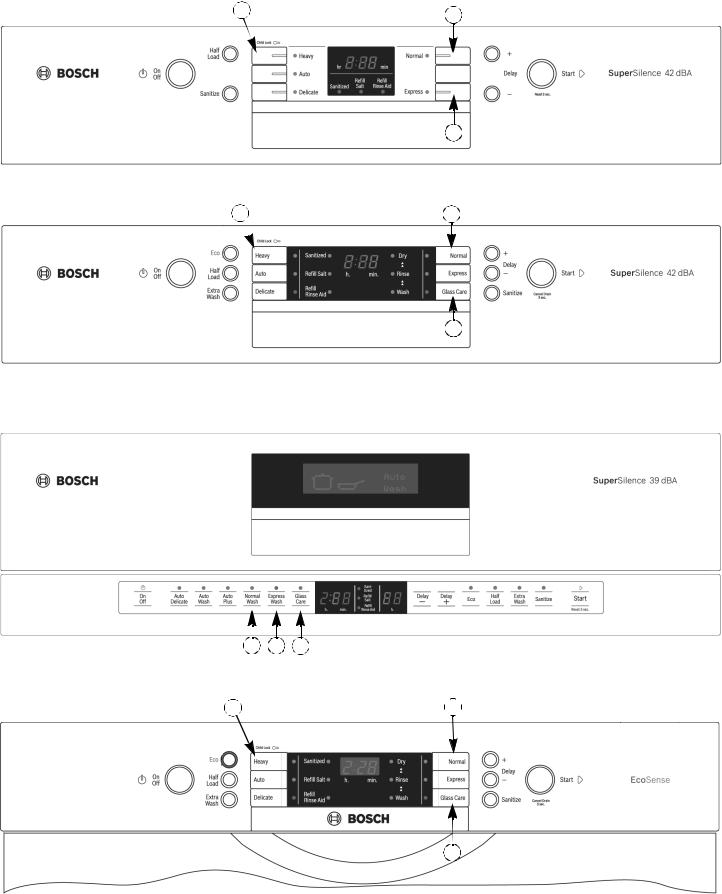
Dishwasher Components
SHE7ER55UC |
B |
SHE8ER55UC |
B |
SHE9ER55UC
A B C
SGE63E15UC |
B |
|
A 
C
A 
C
A 
C 
4
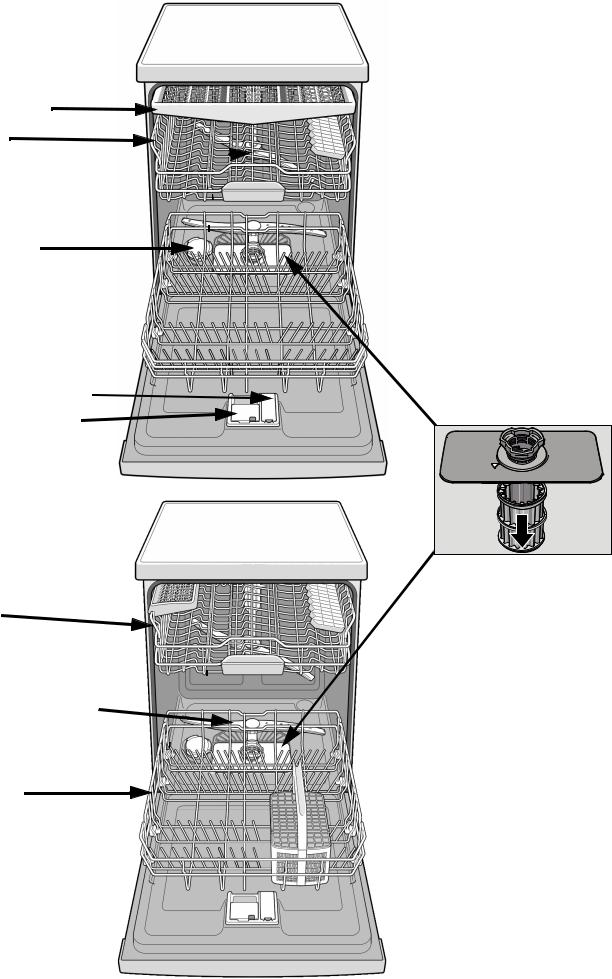
SHExER55UC Models:
Cutlery drawer
Top rack
Top rack spray arm 

Tablet collecting tray 
Bottom rack spray arm
Salt container
Bottom rack
Rinse agent dispenser |
Filter system |
||||
Detergent dispenser |
|||||
|
|
|
|
||
|
|
|
|
|
|
|
|
|
|
|
|
|
|
|
|
|
|
|
|
|
|
|
|
SGE63E15UC Model:
Top rack 
Top rack spray arm

Tablet collecting tray 
Bottom rack spray arm
Salt container 

Bottom rack
Rinse agent dispenser 
Detergent dispenser 

5
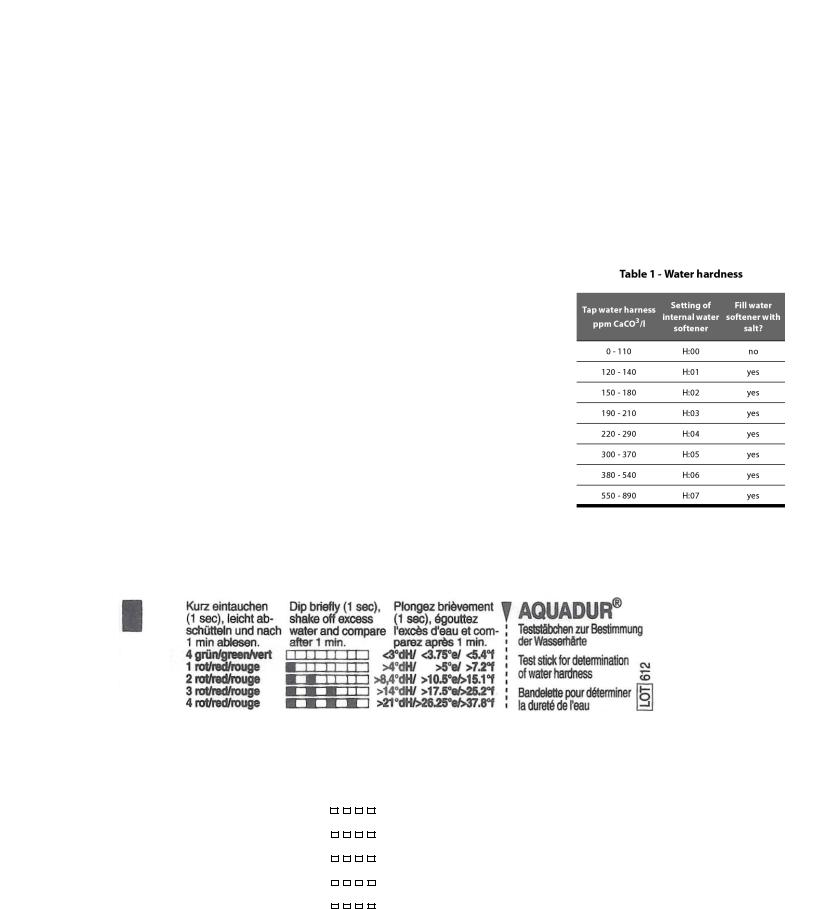
|
|
|
Wash Cycles |
|
|
|
|
|
|
Additional Features |
|
|
|
|
Model |
Heavy |
Auto |
Delicate Normal Express |
Glass |
Adjustable |
Delay |
Eco |
Extra |
Extra Tall |
Flip |
Half Load |
Sanitize |
||
Care |
Top Rack |
Start |
Option |
Wash |
Item |
Tines |
Option |
Option |
||||||
|
|
|
|
|
|
|
|
|
|
Option |
Sprinkler |
|
|
|
|
|
|
|
|
|
|
|
|
|
|
|
|
|
|
SHE7ER55UC |
X |
X |
X |
X |
X |
|
RackMatic |
X |
|
|
X |
X |
X |
X |
|
|
|
|
|
|
|
|
|
|
|
|
|
|
|
SHE8ER55UC |
X |
X |
X |
X |
X |
X |
RackMatic |
X |
X |
X |
X |
X |
X |
X |
|
|
|
|
|
|
|
|
|
|
|
|
|
|
|
SHE9ER55UC |
X |
X |
X |
X |
X |
X |
RackMatic |
X |
X |
X |
X |
X |
X |
X |
|
|
|
|
|
|
|
|
|
|
|
|
|
|
|
SGE63E15UC |
X |
X |
X |
X |
X |
X |
Manual |
X |
X |
X |
|
X |
X |
X |
|
|
|
|
|
|
|
|
|
|
|
|
|
|
|
Dishwasher Setup
Water Softening System
Your dishwasher requires soft water to ensure proper washing results and is equipped with an internal water softening system. However, if you have a household water softening system, the internal system provided is not needed.
For the water softening system to function properly, it will need to use the dishwasher water softening salt. The amount of salt dispensed can be set from “H:00” to “H:07”. Salt is not required at H:00 (this is the default factory setting). The amount of salt required depends on the degree of hardness of your tap water. See Table 1.
1Open the door (for hidden controls only).
2Turn the unit on using the [ON/OFF] button.
3Hold down the “A” button (see page 4) and press [START] until the display indicates “H:00”.
4Release both buttons.
5Press the “C” button to select the desired setting.
6Save the selected setting by pressing [START] and close the door (for hidden controls).
Using the water hardness test strip
|
|
|
|
|
|
|
|
|
|
|
|
|
|
|
|
|
|
|
|
|
|
|
|
|
|
|
|
|
|
|
|
|
|
|
|
|
|
|
|
|
|
|
|
|
|
|
|
|
|
|
|
|
|
|
|
|
|
|
|
|
|
|
|
|
|
|
|
|
|
|
|
|
|
|
|
|
|
|
|
|
|
|
|
|
|
|
|
|
|
|
|
|
|
|
|
|
|
|
|
|
|
|
|
|
|
|
|
|
|
|
|
|
|
|
|
|
|
|
|
|
|
Dip the test strip into tap water for a second. Shake |
After 1 minute |
Setting of |
Fill water |
|
|
||||||||||||
|
|
the test strip will |
internal |
|
|
||||||||||||||
|
|
off excess water and wait approximately 1 minute |
show you the |
water |
softener with |
|
|
||||||||||||
|
|
|
before comparing results. |
salt? |
|
|
|||||||||||||
|
|
|
correct setting |
softener |
|
|
|||||||||||||
|
|
|
|
|
|
|
|
|
|
|
|
|
|
|
|
|
|
||
|
|
|
|
|
|
|
|
|
|
|
|
|
|
|
|
|
|
|
|
|
|
|
|
|
|
|
|
|
|
|
|
|
0 |
H:00 |
no |
|
|
||
|
|
|
|
|
|
|
|
|
|
|
|
|
|
|
|||||
|
|
|
|
|
|
|
|
|
|
|
|
|
|
|
|
|
|
|
|
|
|
|
|
|
|
|
|
|
|
|
|
|
1 |
H:00 |
no |
|
|
||
|
|
|
|
|
|
|
|
|
|
|
|
|
|
|
|||||
|
|
|
|
|
|
|
|
|
|
|
|
|
|
|
|||||
|
|
|
|
|
|
|
|
|
|
|
|
|
|
|
|
|
|
|
|
|
|
|
|
|
|
|
|
|
|
|
|
|
2 |
H:02 |
yes |
|
|
||
|
|
|
|
|
|
|
|
|
|
|
|
|
|
|
|||||
|
|
|
|
|
|
|
|
|
|
|
|
|
|
|
|||||
|
|
|
|
|
|
|
|
|
|
|
|
|
|
|
|
|
|
|
|
|
|
|
|
|
|
|
|
|
|
|
|
|
3 |
H:04 |
yes |
|
|
||
|
|
|
|
|
|
|
|
|
|
|
|
|
|
|
|||||
|
|
|
|
|
|
|
|
|
|
|
|
|
|
|
|||||
|
|
|
|
|
|
|
|
|
|
|
|
|
|
|
|
|
|
|
|
|
|
|
|
|
|
|
|
|
|
|
|
|
4 |
H:06 |
yes |
|
|
||
|
|
|
|
|
|
|
|
|
|
|
|
|
|
|
|||||
|
|
|
|
|
|
|
|
|
|
|
|
|
|
|
|||||
|
|
|
|
|
|
|
|
|
|
|
|
|
|
|
|
|
|
|
|
6

Salt
Refill the salt container, using a funnel to pour, right before turning on the unit to ensure that salt overflow is immediately washed away. This prevents corrosion. See Figure 1.
1Open the screw cap of the salt container.
2Fill the container with water (only required when turning on the unit for the
first time).
3 Add dishwasher salt until the was is displaced and runs out.
4Refill with salt as soon as the salt refill indicator is lit.
Notice: Never fill the salt dispenser with detergent. It will destroy the water softening system. To prevent corrosion, refill with salt and immediately begin any cycle.
Note: Refill salt only when the “Refill Salt” LED is lit.
Do not use salt tablets or any salt other than dishwasher water softening salt.
For more information about ordering salt please contact Customer Service.
Detergent
Use only detergent specifically designed for dishwashers.
Note: To avoid dishwasher damage, do not use hand dishwashing products in your dishwasher.
The dishwasher uses less water, therefore, less detergent is required. With soft water, 1 tablespoon (15ml) of detergent will clean most loads. The detergent dispenser cup has lines that measure detergent (Figure 2) to 1 tablespoon (15ml) and 1.75 tablespoons (25ml). 3 tablespoons (45ml) of detergent will completely fill the detergent dispenser.
Note: If you do not know the hardness of your water supply, use 15ml of detergent. Increase the amount if necessary to the least amount required to get your kitchenware clean.
Use the measuring lines in the detergent dispenser cup as a guide to measure the amount of detergent recommended in Table 2.
To Close:
•Place finger as shown in Figure 3.
•Slide door closed and press down firmly until it clicks.
To Open:
•To open the cover, push the button as shown in Figure 4.
•Cover will slide open.
Table 2- Recommended Detergent Amount
Wash Cycle |
Hard Water/ |
Medium Water/ |
Soft Water/ |
|
Heavy Soil |
Medium Soil |
Little Soil |
||
|
||||
|
|
|
|
|
Heavy |
45ml (3tbsp) |
45ml (3tbsp) |
25-45ml (1.75-3tbsp) |
|
|
|
|
|
|
Auto |
25-45ml (1.75-3tbsp) |
25ml (1.75tbsp) |
15-25ml (1-1.75tbsp) |
|
|
|
|
|
|
Delicate |
25ml (1.75tbsp) |
15-25ml (1-1.75tbsp) |
15ml (1tbsp) |
|
|
|
|
|
|
Normal |
25-45ml (1.75-3tbsp) |
25ml (1.75tbsp) |
15-25ml (1-1.75tbsp) |
|
|
|
|
|
|
Express |
25ml (1.75tbsp) |
15-25ml (1-1.75tbsp) |
15ml (1tbsp) |
|
|
|
|
|
|
Glass Care |
25ml (1.75tbsp) |
15-25ml (1-1.75tbsp) |
15ml (1tbsp) |
|
|
|
|
|
Figure 1
Figure 2
3Tbsp. Max.
2Tbsp. (25ml)
1Tbsp. (15ml)
Figure 3
Figure 4
7
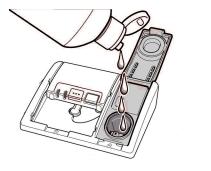
Rinse Aid
Figure 5
To achieve proper drying, always use a liquid rinse aid, even if your detergent contains a rinse aid or drying additive.
Note: The dishwasher indicates low rinse aid by turning on the Refill Rinse Aid LED in the display. If this light is on, you need to refill the rinse aid dispenser by following the directions below.
Adding Rinse Aid
Add liquid rinse aid to the dispenser until the reservoir is full (see Figure 5). Wipe up any excess rinse aid that may puddle when the dispenser reservoir is full. The indicator light will go out a few moments after the dishwasher door is shut. See page 13 for how to adjust the amount of rinse aid dispensed.
Dishware Materials
Note: Before using your dishwasher for the first time, check the information in this section. Some items are not dishwasher safe and should be hand washed; others require special loading.
Recommended
Aluminum: Colored anodized aluminum may fade over time. Minerals in your water may cause the aluminum to darken or spot. This can usually be removed with a soap-filled steel wool pad.
China, Crystal, Stoneware: Some hand-painted utensils may discolor, fade or spot. Hand wash these utensils. Position fragile glassware so that it will not fall over or come in contact with other utensils during the wash cycle.
Glass: Milk glasses may discolor or become yellow.
Non-stick Coatings: Apply a light coating of vegetable oil to non-stick surfaces after drying. Plastics: Make sure the plasticware is dishwasher safe.
Stainless Steel, Sterling Silver and Silver Plates: Load these so they do not come in contact with other metals.
Not Recommended
Acrylic: Crazing, small cracks throughout the acrylic, may occur.
Adhesive-Joined Pieces: Adhesives that join materials such as plastic, wood, bone, steel, copper, tin, etc. may loosen.
Bone-Handled Utensils: Handles may separate.
Iron: Iron will rust. Hand wash and dry immediately.
Non-Dishware Items: Your dishwasher is intended for use in cleaning ONLY standard household dishware and kitchenware.
Pewter, Brass, Bronze: These items will tarnish. Hand wash and dry immediately. Tin: Tin will stain. Hand wash and dry immediately.
Wood: Wooden bowls, wooden utensils and utensils with wooden handles can crack, warp and lose their finish.
Loading the Dishwasher
Do not pre-wash items with loosely attached soiling. Remove all food particles, bones, toothpicks and excessive grease. Items having burned-on, baked-on or starchy soils may require some pretreatment. Refer to the Dishware Materials section for more information about dishware suitability.
Load only dishwasher safe items into the dishwasher. Load dishes in the dishwasher racks so the insides of bowls, pots and pans are facing the spray arms. Avoid nesting and contact points between dishes. Separate items of dissimilar metals.
8
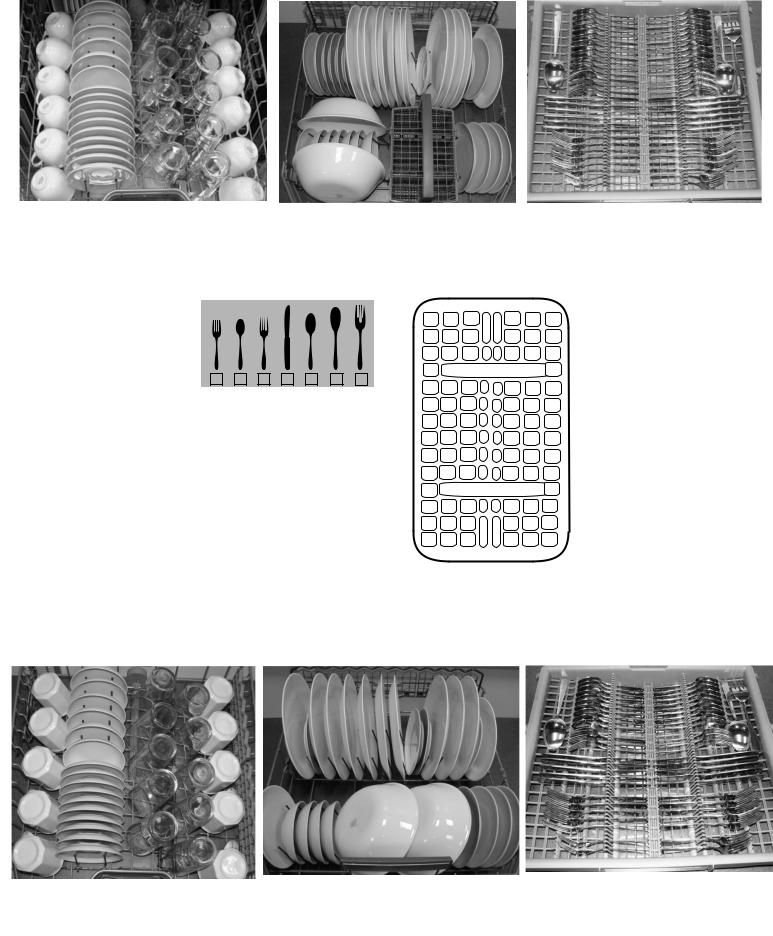
|
Suggested Loading Pattern for Dishes |
|
Top Rack |
Bottom Rack |
Cutlery Rack |
Silverware Basket
|
|
|
|
|
|
|
|
|
|
|
|
|
|
|
|
1 |
|
2 |
|
3 |
|
4 |
|
5 |
|
6 |
|
7 |
|
|
|
|
|
|
|
|
|
|
|
|
|
|
|
|
1- Salad fork
2- Teaspoon
3- Dinner fork
4- Knife
5- Tablespoon
6- Serving spoon
7- Serving fork
3 |
3 |
3 |
1 |
1 |
1 |
4 |
4 |
4 |
4 |
4 |
4 |
6 |
|
7 |
3 |
3 |
3 |
5 |
|
5 |
1 |
1 |
1 |
5 |
|
5 |
2 |
2 |
2 |
5 |
|
5 |
2 |
2 |
2 |
5 |
|
5 |
2 |
2 |
2 |
5 |
|
5 |
2 |
2 |
2 |
5 |
|
5 |
1 |
1 |
1 |
|
|
||||
3 |
3 |
3 |
|
|
6 |
4 |
4 |
4 |
4 |
4 |
4 |
1 |
1 |
1 |
3 |
3 |
3 |
|
Suggested Loading Pattern for Dishes (10 place settings) |
|
Top Rack |
Bottom Rack |
Cutlery Rack |
9

Rack Accessories
Flip Tines
The racks consist of tines that can be folded down depending on what you may need to load in the rack. To fold down, grasp the folding tine and release from notch. Push folding tine downward to desired position as shown in Figure 6.
Extra Tall Item Sprinkler (model dependent)
If an item is too tall to be placed in the bottom rack even with the top rack in the raised position, remove the empty top rack by pulling it out of the dishwasher until it stops. Pull the front of the rack upward and outward until the rollers are completely free of the roller guides.
Set the top rack aside. Push the roller guides back into the dishwasher. Insert the Extra Tall Item Sprinkler into the top rack spray outlet and turn the sprinkler clockwise to lock into position. See Figure 7.
Note: Keep the vent on the tub’s right side clear by placing tall items such as plastic cutting boards and tall baking sheets on the bottom rack’s left side or center.
To avoid dishwasher damage, do not reinstall the top rack without removing the Extra Tall Item Sprinkler.
Plastic Item Clips
Figure 6
1 |
2 |
|
Figure 7
Figure 8
Light-weight plastic accessories (cups, lids, etc.) can be held securely by the plastic item clips. See Figure 8.
3-Step RackMatic® (model dependent)
Figure 9
The height of the upper rack can be adjusted in 3 steps to create more space. 1 Pull the top rack out of the dishwasher until it stops. 2 To lower the rack, push the lever inward then upward. 3 To raise the rack, hold the basket on the sides of the upper rack and lift
up.
10

Manual Rack Height Adjustment (model dependent)
Remove the empty top rack by pulling it out of the dishwasher |
Figure 10 |
|
|
until it can be lifted upward as show in Figure 10. Pull the rack |
|
up and out until the rollers are completely free of the roller |
|
guides. |
|
Reinsert the rack with the other set of rollers on the roller guides |
|
as shown in Figure 11. |
|
Cutlery Drawer (model dependent)
The cutlery drawer horizontally positions knives, spatulas and other oversized tools for improved cleaning and easier loading and unloading. Arrange cutlery in drawer as illustrated in Figure 12.
When loading large items such as pilsner glasses or 10” plates in the upper rack (as seen in Figure 13), the drawer can be removed to allow more room.
To remove:
•Pull empty drawer out of dishwasher until it stops rolling.
•While pulling toward you, lift the front of the drawer upward and outward (see Figure 14) until the rollers are completely free of the roller guides.
•Place empty drawer in safe place.
To reinstall:
•Pull the roller guides on both sides out of the dishwasher.
•Position drawer hooks on top of the roller guides (see Figure 15).
•While holding one roller guide, slide drawer’s top wheel over the roller guide
stop (see Figure 16).
•Repeat on other side.
•Slide drawer back into dishwasher.
Figure 11
Figure 12
Figure 13
Figure 14
Figure 15
Figure 16
11
Dishwasher Cycles and Options
Wash Cycles
Heavy: Best for cleaning items with baked-on food or grease. These dishes would normally require soaking. Auto: With our most complex soil sensing capability, this cycle is perfect for use with mixed loads of dishware with varying amounts of food soil. This is the most flexible cycle and is a good choice for everyday use.
Normal: Thoroughly cleans a full load of normally soiled dishes.
Note: The Energy Guide Label was based on this soil sensing cycle will all available options turned off. As prescribed in the energy test procedure, the unit was tested without any Rinse Aid in the Rinse Aid dispenser. A single dose of detergent was used in the Detergent Dispenser, with no detergent used in the prewash. The test was conducted with the upper rack in the highest position.
Delicate: For delicate or heirloom dishware and silverware or other special items. Always make sure that the items are dishwasher safe. Refer to the Dishware Materials section of this manual for further information. Hand washing may be the best treatment for such items.
Express: Cleans lightly soiled dishes and reduces overall wash time. Use this cycle to clean glasses and dessert dishware that may need to be reused at the same event.
Glass Care (model dependent): A cycle for lightly soiled dishes, ideal for temperature sensitive items or cutlery. In this cycle the temperature is reduced to help prevent dishes from becoming damaged. It is especially helpful to reduce a cloudy or etched appearance on glasses.
Note: Some glasses are more prone to etching due to glass manufacturing processes.
Wash Cycle Options
Delay Start: Allows you to delay the start time of your dishwasher in one hour increments up to 24 hours. Eco Option: Lowers temperature and cycle lenth to decrease energy usage.
Extra Wash (model dependent): This cycle option can be selected to increase wash performance with more water used in extra sequences and at higher temperatures.
Half Load Option: In the Heavy, Auto, Normal, Delicate and Glass Care wash cycles, the Half Load option can reduce the energy and water consumption when washing small, lightly soiled loads that fill approximately half of the dishwasher’s capacity. To activate, select the Half Load button in addition to any of the three cycles listed above.
Sanitize Option: The Sanitize feature is available only in the Heavy, Auto and Normal cycles. Press the “Sanitize Option” button to activate the Sanitation features during the Auto and Normal cycles. The Sanitize light will always be on when running a Heavy cycle. The technical sanitation measures may also improve the drying results.
Note: The dishwasher automatically defaults to Auto Wash when turned off and back on. If you used the sanitize option in your last cycle, the dishwasher will default to Auto Wash with the Sanitize option selected when you turn it on.
Wash Cycle Information
The cycle times in this Use and Care Manual are based on normal soil loads and 120°F incoming water and will vary
based on your actual conditions.
Table 3 - Wash Cycle Information
|
Heavy |
Auto |
Delicate |
Normal |
Express |
Glass Care |
|
|
|
|
|
|
|
cycle time |
110-135 min |
105-129 min |
80-85 min |
95-119 min |
30 min |
70 min |
|
|
|
|
|
|
|
cycle time with Half Load option |
115 min |
95-105 min |
75-80 min |
90-99 min |
not available |
65 min |
|
|
|
|
|
|
|
cycle time with Sanitation option |
125-145 min |
120-140 min |
not available |
115-130 min |
not available |
not available |
|
|
|
|
|
|
|
cycle time with Extra Wash option |
145 min |
120-140 min |
95-105 min |
115-135 min |
not available |
85 min |
|
|
|
|
|
|
|
water consumption |
18.1-23.7 L |
13.1-24.9 L |
8.8-13.9 L |
5.8-16.9 L |
10.3 L |
12.9 L |
|
4.8-6.3 gal |
3.5-6.6 gal |
2.3-3.7 gal |
1.5-4.5 gal |
2.7 gal |
3.4 gal |
|
|
|
|
|
|
|
wash temperature |
66-71°C |
55-66°C |
45-50°C |
50-55°C |
45°C |
50°C |
|
150-160°F |
130-150°F |
113-122°F |
122-131°F |
113°F |
122°F |
|
|
|
|
|
|
|
rinse temperature |
72°C |
70°C |
63°C |
51-69°C |
50°C |
60°C |
|
162°F |
158°F |
145°F |
124-156°F |
122°F |
140°F |
|
|
|
|
|
|
|
Note: Only sanitizing cycles have been designed to meet the requirements of 6 for soil removal and sanitization efficacy. There is no intention, either directly or indirectly, that all cycles have passed sanitization performance tests.
12
Operating the Dishwasher
NOTE: The SHE9ER55UC models have hidden controls, therefore, the door must be opened before changing settings and closed after changing settings.
Start the dishwasher
1 Press the [On/Off] button. The LED of the last selected cycle flashes. 2 Select a cycle and desired options.
3Press [Start].
Cancel a cycle
1 Press and hold the [Start] button for approximately 3 seconds until the display reads “0:01”. 2 Wait about 1 minute while the dishwasher drains.
3Open the door and press the [On/Off] button.
Interrupt a cycle
1Press the [On/Off] button to turn the unit off.
2To resume the cycle, press the On/Off button again.
Setting the amount of rinse aid
The amount of rinse aid dispensed can be set from “r:00” to “r:06”.
To change the setting:
1 |
Press the [On/Off] button. |
2 |
Hold down the “A” button (see page 4) and press [Start] until the display indicates “H:00”. |
3 |
Release both buttons. |
4 |
Press the “A” button until the display shows “r:05”. |
5 |
Press the “C” button to select the desired setting. |
“r:00” = dispenser is OFF “r:01” = lowest setting “r:02” = low setting “r:03” = medium setting
“r:04” = medium/high setting “r:05” = high setting
“r:06” = highest setting
6Press [Start] to save the setting.
Delay Start
You can delay the start of the cycle in one hour increments up to 24 hours.
To set delay start:
1Press the [On/Off] button.
2Press the [+] button until the display jumps to “h:01”.
3 Press the [+] or [-] button until the displayed time corresponds with your requirements. h:01 = 1 hour delay
h:24 = 24 hour delay
4Press [Start] to activate delay start.
To cancel delay start:
1 Press the [+] or [-] button until “h:00” is indicated on the digital display.
2Press [Start] to save setting.
Cycle Completion Signal (SHE9ER55UC only)
1Open the door and press the [On/Off] button.
2 Hold down the “A” button (see page 4) and press [Start] until the display indicates “H:00”.
3Release both buttons.
4Press the “A” button until the display shows “b:02”.
5 Press the “C” button to increase or decrease the tone “b:00” = OFF and “b:03” = LOUDEST
6Press [Start] to save setting and close the door.
13
Intensive Drying
The final rinse uses a higher temperature which improves the drying results. The running time may increase slightly.
To turn intensive drying on:
1Press the [On/Off] button.
2 Hold down the “A” button (see page 4) and press [Start] until the display indicates “H:00”.
3Release both buttons.
4Press the “A” button until the display shows “d:00”.
5 Press the “C” button to turn intensive drying on or off. “d:01” = ON and “d:00” = OFF
6Press [Start] to save setting and close the door.
Auto Power Off
To save energy, the dishwasher is turned off 1 minute after the wash cycle ends. Auto Power Off can be adjusted from P:00 to P:02.
To change the factory setting (P:01):
1Press the [On/Off] button.
2 Hold down the “A” button and press [Start] until the display indicates “H:00”.
3Release both buttons.
4Press the “A” button until the display indicates “P:01”.
5 Press the “C” button until the display corresponds with your requirements. P:00 = dishwasher does not turn off automatically
P:01 = dishwasher turns off automatically after 1 minute
P:02 = dishwasher turns off automatically after 120 minutes (2 hours)
6Press [Start] to save the setting.
To change the language:
1Press the [On/Off] button.
2 Hold down the “A” button and press [Start] until the display indicates “H:00”.
3Release both buttons.
4Press the “A” button until the display indicates “L:01”.
5 Press the “C” button until the display corresponds with your requirements. L:02 = English
L:03 = French
L:07 = Spanish
6Press [Start] to save the setting.
14

Care and Maintenance
A regular inspection and maintenance of your machine will help to prevent faults. This saves time and prevents future problems.
Overall condition of the machine
Never use a steam cleaner to clean your dishwasher. The manufacturer is not liable for any consequential damage.
Regularly wipe the front of the appliance with a damp cloth - water and a small amount of liquid soap is adequate. Do not use sponges with a rough surface or abrasive detergents, as these could scratch the surfaces.
Stainless steel appliances: To prevent corrosion, avoid using sponge cloths.
Clean the outer edges of the inside door panel regularly to remove debris that may collect from normal loading. If spots begin to appear on the stainless steel, make sure the rinse agent is full and functioning properly.
Filters
The filter system consists of a coarse filter, a flat fine filter and a micro filter. The filters keep large foreign objects in the rinsing water away from the pump. Foreign objects may occasionally block the filters.
Check the filters for residue by:
•Unscrew the filter cylinder as illustrated in Figure 17-18 and take out the filter system.
•Remove any residue and clean filters under running water.
•Reinstall filter system in reverse sequence and ensure that the arrow marks are facing each other after locking it into place.
Spray Arms
Check spray arms for grease and limescale deposits.
If you find such deposits:
•Fill detergent dispenser with detergent and start the appliance without utensils in the cycle with the highest rinsing temperature (see wash cycle information table).
•Clean the appliance with detergents/ appliance cleaners which are particularly suitable for use with dishwashers.
•Unscrew the spray arms and inspect as shown in Figure 19.
Waste water pump
Large food remnants in the rinsing water not retained by the filters may block the waste water pump. the rinsing water does not get pumped out and covers the filters.
In this case:
•Disconnect the appliance from the power supply.
•Remove the filters.
•Scoop out standing water - use a sponge if necessary.
•Using a spoon, pry off the pump cover (see Figure 20-21) until it clicks, then grip the cover and pull upward until it resists and then pull forward.
•Check inner compartment and remove any foreign objects.
•Place cover in the original position, press down and engage.
•Reinstall filters.
Figure 17
Figure 18
Figure 19
1 |
2 |
Figure 20
1 |
Figure 21
2 |
3 |
KLICK |
|
|
15 |
Self Help
Dishwashers may occasionally exhibit problems that are unrelated to a malfunction of the dishwasher itself. The following information may help you with a dishwasher problem without involving a repair professional.
Problem |
Cause |
Action |
|
|
|
|
|
|
1. Door may not be properly latched |
1. Shut the door completely |
|
|
2. Unit may not be turned on |
2. Press the main power switch to turn unit on |
|
|
3. Unit not reset or previous cycle not completed |
3. To reset, refer to “cancelling or changing cycle” in this |
|
Dishwasher |
4. Delay start engaged |
manual |
|
5. Interruption of electrical power supply to dishwasher or |
4. To reset, refer to “delay start” section in this manual |
||
does not start |
|||
blown fuse. |
5. Check circuit breaker |
||
|
|||
|
6. The door may have been closed without first selecting a |
6. Select a cycle and close the door. |
|
|
cycle |
7. Check and turn on water supply |
|
|
7. Water supply may not be turned on |
|
|
|
|
|
|
Dishwasher |
1. Default factory settings alert the customer that the cycle |
1. To adjust the volume or deactivate, refer to the “cycle |
|
beeping (end of |
is complete by beeping. This feature can be deactivated if so |
completion signal” section in this manual. |
|
cycle signal) |
desired. |
|
|
|
|
|
|
Display does not |
1. A fuse may have been blown or circuit breaker tripped |
1. Check the fuse or circuit breaker box and replace the |
|
illuminate or |
2. Door not closed or latched |
fuse or reset the breaker if necessary |
|
console lights |
Note: For models with controls on top of the door, the dis- |
2. Ensure door is properly latched and completely closed |
|
are not on |
play only illuminate when the door is opened and controls |
|
|
|
are visible. |
|
|
|
|
|
|
Dishwasher |
1. Incoming water is not warm enough |
1. Before starting a cycle, run hot water faucet at the sink |
|
seems to run a |
2. Cycle time can vary due to soil and water conditions |
closest to the dishwasher |
|
long time |
3. Rinse agent dispenser is empty |
2. Sensors in the dishwasher automatically increase the |
|
|
4. Dishwasher connected to cold water supply |
cycle time to ensure a good wash when heavy soil is |
|
|
Note: Refer to “wash cycle information” section in this man- |
detected |
|
|
ual for typical cycle lengths |
3. Add rinse agent |
|
|
|
4. Verify dishwasher is connected to hot water supply |
|
|
|
plumbing |
|
|
|
|
|
Dishes are not |
1. Spray arm movement obstructed |
1. Ensure that spray arm movement is not blocked by |
|
getting clean |
2. Spray arm nozzles clogged |
hand rotating spray arms before starting cycle |
|
enough |
3. Improper use of detergents |
2. Remove the spray arms and clean according to the |
|
|
4. Filters could be clogged |
“care and maintenance” section of the manual |
|
|
5. Dishes are nested or loaded too close together |
3. Increase or decrease detergent depending on the |
|
|
6. Selected wash cycle is not suitable for food soil conditions |
water hardness (refer to Table 1) |
|
|
|
4. Clean the filters according to the “care and mainte- |
|
|
|
nance” section of the manual |
|
|
|
5. Rearrange load such that water spray can reach all |
|
|
|
items in the dishwasher - see “loading the dishwasher” |
|
|
|
section of the manual |
|
|
|
6. Refer to “wash cycle information” section of the manual |
|
|
|
|
|
Dishes are not |
1. Rinse agent dispenser is empty |
1. Add rinse agent - the use of rinse agent improves dry- |
|
getting dry |
2. Improper loading of dishes |
ing |
|
enough |
3. Selected cycle does not include drying |
2. Rearrange load to ensure items are not nesting (see |
|
|
Note: Plastic or Teflon do not typically dry as well as other |
“loading the dishwasher” section of the manual) |
|
|
items due to their inherent properties |
3. Rinse and Hold setting does not include drying |
|
|
|
Note: Santitize option and Intensive Drying feature also |
|
|
|
improve drying performance. |
|
|
|
|
16

Problem |
Cause |
Action |
|
|
|
Odor |
1. Food debris is present at the bottom of the dishwasher |
|
2. Food particles are present near the door seal |
|
3. Dishes left in unit too long before running a cycle |
|
4. Residual water is present at the bottom of the dishwasher |
|
5. Drain hose is obstructed |
1.Remove the filters and clean according to the “care and maintenance” section of the manual
2.Refer to “care and maintenance” section of the manual
3.Run a Rinse and Hold cycle if you do not intend to immediately wash the dishes
4.Ensure the unit has completely drained from the last cycle
5.Remove any obstructions from the drain hose by calling qualified personnel.
Note: If odor still persists, run the Normal/Regular cycle until it flushes and interrupt the cycle and place an 8oz. cup of distilled white vinegar solution on the top rack and then finish the cycle.
Dishwasher not |
1. Restriction in the water supply system |
1. Ensure that the water supply valve (typically located |
filling with |
2. Previous wash cycle was not completed |
under kitchen sink) is open and check that the water sup- |
water |
3. Delay start is active |
ply line has no kinks or clogs |
|
|
2. Refer to the “operating the dishwasher” section of the |
|
|
manual. |
|
|
3. Cancel the delay start or wait until delay start time com- |
|
|
pletes |
|
|
|
Water leaks |
1. Suds |
1. Wrong type of detergent results in suds and leaks - use |
|
2. Door seal could be pulled away from track |
only dishwasher detergents. If suds still persist, add one |
|
3. Condensation vent is blocked |
tablespoon of vegetable oil at the bottom of the dish- |
|
4. Improper installation |
washer and run the desired cycle. |
|
|
2. Ensure the door seal is in the track |
|
|
3. Ensure that condensation vent is not blocked |
|
|
4. Have proper installation verified by qualified personnel |
|
|
(water supply, drain system, leveling, plumbing) |
|
|
|
Tub stains |
1. Stains on the dishwasher interior are due to water hard- |
1. Concentrated lemon juice can reduce the build up of |
|
ness |
hard water stains. Run a Regular cycle until it flushes and |
|
2. Silverware in contact with tub |
interrupt the cycle and then place an 8oz. cup of the con- |
|
|
centrated lemon solution on the top rack and finish the |
|
|
cycle. this can be done periodically to avoid build up. |
|
|
2. Ensure that silverware does not make contact with the |
|
|
tub while running a cycle. |
|
|
|
Streaks on glass- |
1. Incorrect rinse agent setting |
1. Depending on the hardness of water, adjust the rinse |
ware or residue |
|
agent dispenser. Refer to “Adding detergent and rinse |
on the dishes |
|
agent” section in the manual |
|
|
|
Fascia panel dis- |
1. Abrasive cleaner used |
1. Use mild detergents with soft damp cloth |
colored or |
|
|
marked |
|
|
|
|
|
Noise during |
1. Dishes may not be arranged properly |
1. Water circulation sound is normal, but if you suspect |
wash cycle |
|
items are banging into each other or into the spray arms, |
|
|
refer to the “loading the dishwasher” section of the man- |
|
|
ual for optimal arrangement. |
|
|
|
Detergent dis- |
1. Improper operation of detergent cover |
1. Refer to “Adding detergent and rinse agent” section of |
penser cover |
2. Previous cycle has not been finished or rest or cycle or |
the manual for instructions on opening and closing the |
will not shut |
interrupted |
dispenser |
|
|
2. Refer to the “operating the dishwasher” section of the |
|
|
manual |
|
|
|
Unable to select |
1. Previous cycle has not finished |
1. Refer to the “Operating the Dishwasher” section of the |
desired cycle |
|
manual |
|
|
|
17

Customer Service
Your Bosch dishwasher requires no special care other than that described in the Care and Maintenance section of this manual. If you are having a problem with your dishwasher, before calling for service please refer to the Self Help section of the manual. If service is necessary, contact your dealer or installer or an authorized service center. Do not attempt to repair the appliance yourself. Any work performed by unauthorized personnel may void the warranty.
If you are having a problem with your Bosch dishwasher and are not pleased with the service you have received, please take the following steps until the problem is corrected to your satisfaction:
1Call us at 1-800-944-2904
2Contact Customer Service from our web site:
www.bosch-home.com/us (USA) or www.bosch-appliances.ca (Canada)
3Contact your installer or the Bosch Authorized Service Contractor in your area.
Please be sure to include your model information as well as an explanation of the problem and the date it started.
You will find the model and serial number information on the label located on the edge of the dishwasher door.
Also, please include a daytime phone number where you can be reached.
Please make a copy of your invoice and keep it with this manual. The customer much show proof of purchase to obtain warranty service.
This Bosch dishwasher is backed by the Good Housekeeping Seal. The limited warranty
reflected by the Good Housekeeping Seal means that if a product bearing the Seal is defective
This Bosch dishwasher is backed by the Good housekeeping Seal. The limited within the first two years of purchase, Good Housekeeping will replace the product or refund
warranty reflected by the Good Housekeeping Seal means that if a product bearing the the purchase price. For details please visit GHSeal.com.
Seal is defective within the first two years of purchase, Good Housekeeping will replace the product or refund the purchase price. For details please visit GHSeal.com
18
